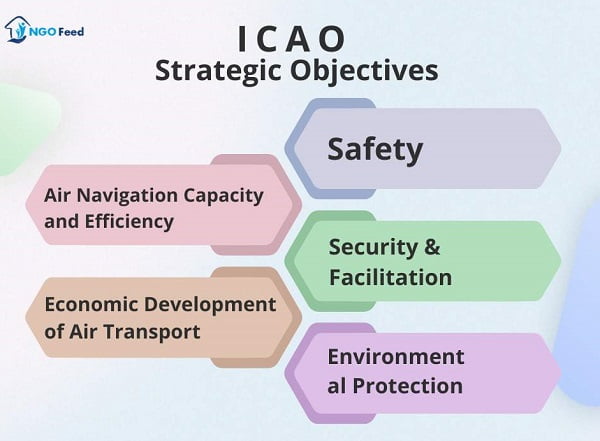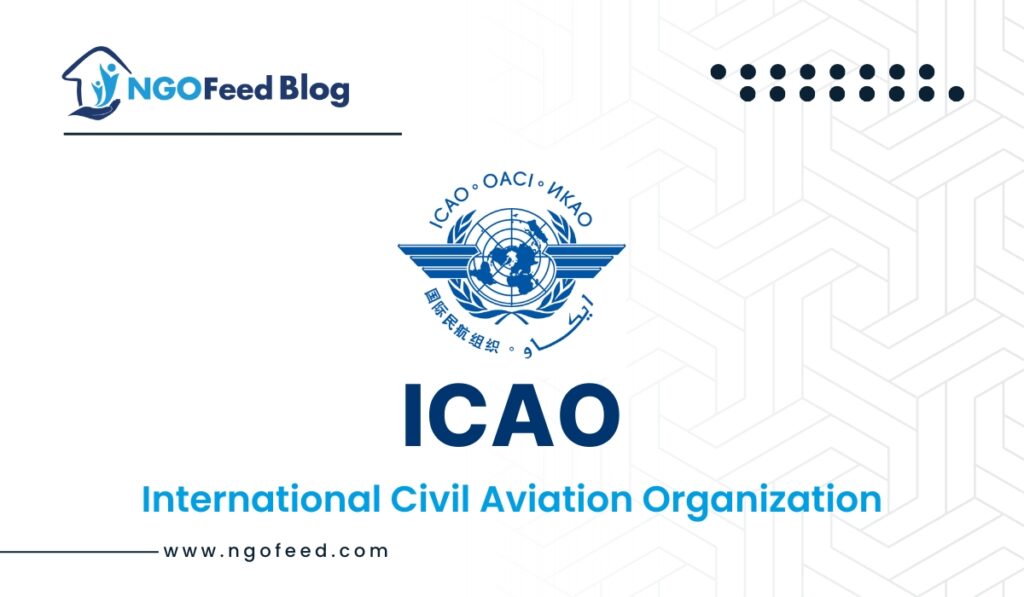ICAO Full Form: International Civil Aviation Organization (ICAO) headquarters is located in the Quartier International of Montreal, Quebec, Canada. ICAO full form is International Civil Aviation Organization. It was funded and directed by 1947 national governments to support their diplomacy and cooperation in air transport as signatory states to the Chicago Convention (1944). Air Navigation Commission (ANC) is the scientific body within ICAO. Approved by the commission, rules are sent to the council, the political body of ICAO, for discussion and coordination with the member states before final permission.
The requirements ICAO standards include never supersede the importance of national regulatory requirements. It is always the local and federal regulations enforced in and by sovereign states which must be legally adhered to by air operators using applicable airspace and airports.
Table of Contents
ICAO Overview
Here in this section, we provide a short overview of ICAO (International Civil Aviation Organization). Let’s have a look.
| ICAO | International Civil Aviation Organization |
| Headquarters | Montreal, Canada |
| Formation | 1947 |
| Parent organization | ECOSOC |
| Type | UN specialized agency |
| Status | Active |
| Website | https://www.icao.int |
Read also:
History of ICAO
The International Commission for Air Navigation was the ICAO (ICAN) precursor. It convened its first convention in Berlin, Germany, in 1903, but the eight countries that attended could not agree. Twenty-seven countries attended the second congress, which was also held in Berlin in 1906. The first radio callsigns for aeroplanes were assigned during the third convention, which was held in London in 1912. ICAN was in operation until 1945.
The Chicago Convention on International Civil Aviation, usually known as the Chicago Convention, was signed on December 7, 1944, in Chicago, Illinois, by 52 countries. Its terms called for creating a Provisional International Civil Aviation Body, which would be replaced by a permanent organisation once twenty-six countries signed the agreement. PICAO was established as a result of this.
PICAO, which took over from ICAN on June 6, 1945, was established. The twenty-sixth country accepted the treaty on March 5, 1947, and PICAO was disbanded on April 4, 1947, to be replaced by ICAO, which commenced operations the same day. In October 1947, the International Civil Aviation Organization (ICAO) became a United Nations entity, reporting to the UN’s Economic and Social Council (ECOSOC).
Montreal is home to the International Civil Aviation Organization (ICAO).
Qatar offered to serve as the Organization’s new permanent seat in April 2013. Qatar proposed to build a vast new headquarters for ICAO and cover all relocation costs, claiming that Montreal was “too far from Europe and Asia,” “had chilly winters,” was difficult to attend due to the Canadian government’s sluggish visa issuing, and that the taxes imposed on ICAO were “too high.”
ICAO Structure: Assembly, Council, and Secretariat
- There is an Assembly, a Council, and a Secretariat that make up ICAO.
- Every three years, all twenty-one Contracting States meet in the Assembly to talk about ICAO’s work and make decisions about its rules.
- The 26th Assembly chooses 36 member states for the Council, which has 36 members picked based on different factors.
- The Council decides what ICAO does, makes Standards and Recommended Practices, and keeps an eye on different groups like the Air Transport Committee and the Air Navigation Commission.
- The five main parts of the Secretariat are Air Navigation, Air Transport, Technical Cooperation, Legal, and Administration. The Secretary General is in charge of the whole organization.
- Along with non-governmental groups like IATA, ACI, IFALPA, and IAOPA, ICAO works closely with UN bodies like WMO, ITU, UPU, WHO, and IMO.
Read also:
ICAO Strategic Objectives

Council of ICAO
Every three years, the Assembly elects the ICAO Council, which consists of 36 members elected in three groups. The current Council was elected in October 2022. The current Council is structured as follows:
| Group I (Chief Importance) | Group II (Large Contributions) | Group III (Geographic Representations) |
|---|---|---|
| Australia Brazil Canada China France Germany Italy Japan United Kingdom United States | Argentina Austria Egypt Iceland India Mexico Nigeria Saudi Arabia Singapore South Africa Spain Venezuela | Bolivia Chile El Salvador Equatorial Guinea Ethiopia Ghana Jamaica Malaysia Mauritania Qatar South Korea Romania United Arab Emirates Zimbabwe |
List of Council Presidents
| President | Country of nationality | Term |
|---|---|---|
| Salvatore Sciacchitano | Italy | 2020–present |
| Olumuyiwa Benard Aliu | Nigeria | 2013–2019 |
| Roberto Kobeh Gonzalez | Mexico | 2006–2013 |
| Assad Kotaite | Lebanon | 1976–2006 |
| Walter Binaghi | Argentina | 1957–1976 |
| Edward Pearson Warner | United States | 1947–1957 |
ICAO and India
India has been a part of the International Civil Aviation Organization (ICAO) since its start in 1944. India has a voice in the rules for international air travel because it has a regular agent in Montreal. India brought up a problem at ICAO not long ago when Pakistan refused to let a diplomatic aeroplane fly through its area in 2019. This is an example of how India uses its ICAO position to help make foreign air travel better.
Read also:
Conclusion
The International Civil Aviation Organization (ICAO) has been a key player in promoting unity in air travel around the world since its founding in 1944. Standards and rules set by the ICAO make sure that flight is safe and runs smoothly. Its offices are in Montreal, Canada, and it has 194 member states. ICAO is still dedicated to improving international air travel for the benefit of all countries, and it is growing under the direction of Salvatore Sciacchitano, who is currently President.
Frequently Asked Questions (FAQs)
What is the full form of ICAO?
The full form of the ICAO International Civil Aviation Organization.
Where is the headquarters of ICAO located?
The headquarter of ICAO is in Montreal, Canada
Which countries are not in ICAO?
The only non-Contracting States are the Holy See and Liechtenstein.
Why was ICAO formed?
ICAO was created to promote the safe and efficient development of civil aviation. One enduring aspect of the Organization’s work over the last six decades has been to help States improve civil aviation in their country through projects implemented under ICAO’s Technical Cooperation Programme.
Where was ICAO founded?
ICAO was founded in the year of 4 April 1947.
Who are members of ICAO?
The following States were elected from among ICAO’s 193 Member States to the Organization’s 36 Member Governing Council during the 2019 ICAO Assembly. Australia, Brazil, Canada, China, France, Germany, Italy, Japan, Russian Federation, the United Kingdom and the United States.

